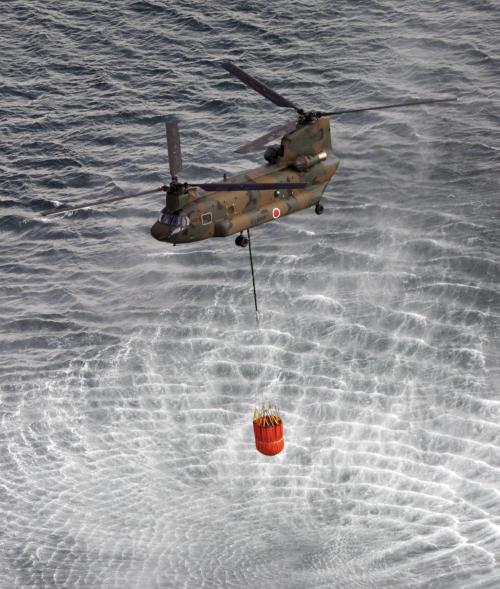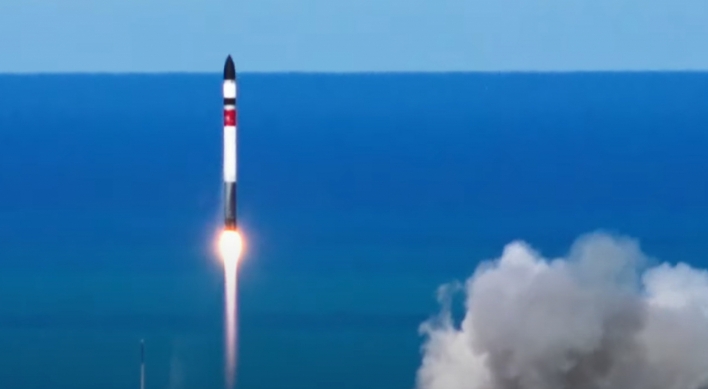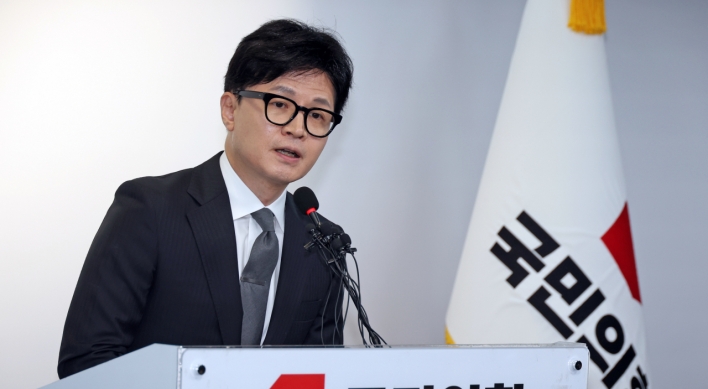Fuel rod cooling pool nearly empty, plant owner says
U.S. officials say No. 4 reactor also in trouble
ZAO, Japan (AP) ― Military helicopters dumped loads of seawater onto Japan’s stricken nuclear complex Thursday, turning to combat-style tactics while trying to cool overheated uranium fuel that may be on the verge of spewing out more radiation.
Plant operators also said they were racing to finish a new power line that could restore cooling systems and ease the crisis at the Fukushima Daiichi plant on the country’s northeast coast.
The top U.S. nuclear regulatory official gave a far bleaker assessment of the situation than the Japanese, and the U.S. ambassador said the situation was “deteriorating” while warning U.S. citizens within 80 kilometers of the complex to leave the area or at least remain indoors.
The Japanese government said it had no plans to expand its mandatory, 20-kilometer exclusion zone around the plant, while also urging people within 30 kilometers to stay inside.
The troubles at the nuclear complex were set in motion last week’s 9.0-magnitude earthquake and tsunami knocked out power and destroyed backup generators needed for the reactors’ cooling systems. That added a nuclear crisis on top of twin natural disasters that likely killed well more than 10,000 people and left hundreds of thousands homeless.
Four of the plant’s six reactors have faced serious crises involving fires, explosions, damage to the structures ousing reactor cores or rising temperatures in the pools used to store spent nuclear fuel. Officials also recently announced that temperatures are rising in the spent fuel pools of the last two reactors.
Two Japanese military CH-47 Chinook helicopters began dumping seawater on the complex’s damaged Unit 3 at 9:48 a.m., defense ministry spokeswoman Kazumi Toyama said. The choppers dumped at least four loads on the reactor in just the first 10 minutes, though television footage showed much of it appearing to disperse in the wind.
Chopper crews were flying missions of about 40 minutes each to limit their radiation exposure, passing over the reactor with loads of about 7,500 liters (about 2,000 gallons) of water.
The water drops were aimed at cooling the Unit 3 reactor, as well as replenishing water in that unit’s cooling pool, where used fuel rods are stored, Toyama said. The plant’s owner, Tokyo Electric Power Co., said earlier that pool was nearly empty, which would cause the rods to overheat and emit even more radiation.
Defense Minister Toshifumi Kitazawa told reporters that emergency workers had no choice but to try the water dumps before it was too late.
U.S. officials, meanwhile, said Unit 4 also was seriously at risk.
U.S. Nuclear Regulatory Commission Chairman Gregory Jaczko said at a congressional hearing in Washington that all the water was gone from that unit’s spent fuel pool. Jaczko said anyone who gets close to the plant could face potentially lethal doses of radiation.
“We believe radiation levels are extremely high,” he said.
Tokyo Electric executives said Thursday that they believed the rods in that pool were covered with water, but an official with Japan’s nuclear safety agency later expressed skepticism about that and moved closer to the U.S. position.
“Considering the amount of radiation released in the area, the fuel rods are more likely to be exposed than to be covered,” Yuichi Sato said.
Chief Cabinet Secretary Yukio Edano said that along with the helicopter water drops, special police units would use water cannons ― normally used to quell rioters ― to spray water onto the Unit 3 storage pool. The high-pressure water cannons will allow emergency workers to stay farther away.
Emergency workers were forced to temporarily retreat from the plant Wednesday when radiation levels soared, losing precious time. While the levels later dropped, they were still too high to let workers get close.

The storage pools need a constant source of cooling water. Even when removed from reactors, uranium rods are still extremely hot and must be cooled for months, possibly longer, to prevent them from heating up again and emitting radioactivity.
A core team of 180 emergency workers has been at the forefront of the struggle at the plant, rotating in and out of the complex to try to reduce their radiation exposure.
But experts said that anyone working close to the reactors was almost certainly being exposed to radiation levels that could, at least, give them much higher cancer risks.
“I don’t know any other way to say it, but this is like suicide fighters in a war,” said Keiichi Nakagawa, associate professor of the Department of Radiology at University of Tokyo Hospital.
Experts note, though, that radiation levels drop quickly with distance from the complex. While elevated radiation has been detected well outside the evacuation zone, experts say those levels are not dangerous.
U.S. officials were taking no chances, and Prime Minister Naoto Kan and U.S. President Barack Obama spoke about the crisis early Thursday.
In a statement, U.S. Ambassador John V. Roos made his evacuation recommendation “in response to the deteriorating situation” at the Fukushima complex. In Washington, the State Department warned U.S. citizens to consider leaving the country, and offered voluntary evacuation to family members and dependents of U.S. personnel in the cities of Tokyo, Yokohama and Nagoya.
Chartered planes also would be brought in to help private American citizens who wished to leave, the State Dept. said.
Japanese officials raised hopes of easing the crisis early Thursday, saying they may be close to bringing power back to the plant and restoring the reactors’ cooling systems.
The new power line would revive electric-powered pumps, making it easier for workers to control the high temperatures that may have led to partial meltdowns in three reactors. The company is also trying to repair its existing disabled power line.
Tokyo Electric officials said they hoped to have the power line working later Thursday, and had electricians standing by to connect the power plant.
Nearly a week after the disaster, police said more than 452,000 people were staying in schools and other shelters, as supplies of fuel, medicine and other necessities ran short. Both victims and aid workers appealed for more help.
“There is enough food, but no fuel or gasoline,” said Yuko Niuma, 46, as she stood looking out over Ofunato harbor, where trawlers were flipped on their sides.
Along the tsunami-savaged coast, people must stand in line for food, gasoline and kerosene to heat their homes. In the town of Kesennuma, they lined up to get into a supermarket after a delivery of key supplies, such as instant rice packets and diapers.
Each person was only allowed to buy 10 items, NHK television reported.
With diapers hard to find in many areas, an NHK program broadcast a how-to session on fashioning a diaper from a plastic shopping bag and a towel.
More than 5,300 people are officially listed as dead, but officials believe the toll will climb to well over 10,000.
The chief of the U.N. nuclear agency, Yukiya Amano, said he would go to Japan to assess what he called a “very serious” situation and urged Tokyo to provide better information to his organization.
Other countries have complained that Japan has been too slow and vague in releasing details about its rapidly evolving crisis at the complex of six reactors along Japan’s northeastern coast.
<관련 한글 기사>
<日대지진> 원전 상황 Q&A
Q "핵폭발 가능성은", A "근본적으로 불가능"
Q "전력공급 재개되면", A "냉각수 공급 원활"
Q "한국 상공 VAAC 경보는", A "비행정보구역 표시"
일본 후쿠시마(福島) 원전 사고가 노심 용해(원자로가 녹는 현상)와 수소 폭발, 사용후 핵연료봉 노출 등 원전에서 우려할 만한 거의 모든 종류의 위험을 안은 채 발생 1주일을 맞고 있다.
다행히 전력 공급이 재개됐으나, 아직 수습 국면이라고 예단하기는 어려운 상황 이다.
후쿠시마 원전 사태와 관련, 현 시점에서 궁금한 몇 가지 내용을 정리했다.
◇ 핵분열ㆍ핵폭발 가능성은 = 3ㆍ4호기의 경우 '사용후 핵연료봉'이 제대로 식 지 않아 문제가 되고 있다. 사용후 핵연료봉을 담는 수조의 냉각수 수위가 낮아졌거 나 고갈돼 핵연료봉이 공기에 노출된 상태로 추정된다.
핵연료봉 온도가 높아지면서 핵연료봉을 싼 피복재(지르코늄)의 산화로 수소가 발생, 이미 3ㆍ4호기에서 모두 수소 폭발이 일어난 바 있다.
그러나 녹은 핵연료봉의 우라늄들이 한데 모여 다시 핵분열 반응을 일으키는, 이른바 '재임계'의 가능성은 크지 않다는 게 전문가들의 견해다. 사용후 핵연료봉에 1% 미만의 핵분열 물질(우라늄-235)만 남아 있어, 매우 많은 양이 조밀하게 모이고 감속재 역할을 할 물이 더해지지 않으면 분열에 이르기 어렵기 때문이다.
핵폭탄과 같은 핵폭발은 근본적으로 불가능하다. IAEA가 인정한 핵폭탄 실험이 가능한 최소 농도의 우라늄 농도는 20%다.
◇ 왜 헬리콥터로 원전에 물 붓나 = 일본 측은 현재 자위대 헬리콥터를 이용해 3호기와 4호기 상공에서 물을 쏟아붓고 있다. 이는 대부분 사용후 핵연료봉 냉각을 위한 것으로 추정된다.
사용후 핵연료봉 저장 수조는 원자로 및 격납용기 밖에 있고, 위쪽이 개방된 수 영장 형태이다. 따라서 현재 외벽 건물 상단이 뚫린 상태에서는 상공에서 물을 쏟아 부어 수조를 다시 채우는 방법을 고려할 수 있다. 현재 방사선 피폭 등에 대한 우려로 직접 작업원들이 투입돼 수조에 물을 채우는 것이 여의치 않기 때문이다.
헬리콥터에서 내리붓는 물에는 핵분열(재임계)을 막기 위해 붕산 등 중성자 흡수 물질이 포함돼 있다.
결과적으로는 수조뿐 아니라 격납용기 외부에도 물이 닿겠지만, 원자로 내부 핵 연료봉이 노출되고 과열되는 상황이라면 격납용기 겉을 식히는 일은 큰 의미가 없다.
◇ 전력공급 재개되면 상황이 어떻게 바뀌나 = 17일 후쿠시마 원전의 새 전력선 설치가 거의 끝나 전력 공급이 일부 재개됐다는 반가운 소식이 전해지고 있다.
전력 공급이 중요한 것은 이번 후쿠시마 원전 사태의 근본 원인이 지진에 따른 비상 디젤발전기 고장으로 원전의 냉각 시스템이 망가진 데 있기 때문이다. 냉각수 공급이 제대로 되지 않자 원자로 안의 핵연료봉, 사용후 핵연료봉 모두 남은 열(殘熱)이 살아나 노심용해(원자로가 녹는 현상)가 실제로 일부 일어났고, 이제 핵분열 가능성까지 거론되고 있는 것이다.
시설의 고장 유무에 따라 다르지만, 전원이 들어오면 냉각수 공급장치를 다시 가동해 비상으로 끌어 온 바닷물을 원자로 안에 주입, 달궈진 또는 녹고 있는 핵연료봉을 빠르게 식힐 수 있다. 다만 갑자기 많은 물이 뜨거운 노심과 반응하면 '증기 폭발' 가능성이 있는 만큼, 냉각수 공급속도를 조절해야 한다.
전기 공급으로 '서프레션 풀' 같은 압력제어 장치가 살아나면 격납용기 내부 압력을 낮춰 냉각수 공급이 더 원활해질 수도 있다. 수소를 제거하는 시스템이 재가동 된다면 그동안 잇따랐던 '수소 폭발'의 위험도 크게 낮아질 것으로 기대된다.
이처럼 전력 공급은 이번 후쿠시마 원전 사태가 안정 국면으로 접어드는 계기가 될 수 있다. 그러나 전력 공급이 이뤄지더라도 해당 시설들이 제대로 작동할지는 아 직 불투명하다.
◇ 사고 수습을 위해 남은 '최후 50인' 안전은 = 원전 근로자나 구조대의 경우 원전 폭발과 같은 최악의 상황에서 일반인과 완전히 다른 안전 기준이 적용된다. 국제원자력방호위원회(ICRP)의 2007년 권고안을 보면, '비상 피폭상황'에서 인명 구조 가 필요한 경우 방사선 노출량의 제한을 두지 않고 있다.
일본을 비롯한 대다수 국가가 ICRP의 권고를 따르는 것을 감안할 때, 안타깝지만 일본 후쿠시마 원전에 남은 도쿄전력 직원들의 경우 피폭량이 일정 수치 이상으로 높아져도 업무에서 자동적으로 제외되지 않을 것으로 전문가들은 추정하고 있다.
실제로 일부 직원은 지인에게 보낸 이메일에서 '죽을 준비가 돼 있다'고 말했다고 한다.
그러나 아직까지 일본 정부는 직원들의 피폭량을 최대한 줄이려는 노력을 계속 기울이고 있다. 도쿄전력도 지난 16일 한때 원전 주변의 방사선 수치가 400mSv(밀리 시버트)까지 치솟자 직원 전체를 일시적으로 철수시키기도 했다.
◇ VAAC '한국 상공 방사선 경보' 의미는 = 영국 소재 화산재예보센터(VAAC)는 지난 16일 후쿠시마 원전 사고 여파로 한국ㆍ일본ㆍ중국ㆍ러시아ㆍ미국 등의 상공에 방사선 위험 가능성이 있다고 공식 경보를 발령했다.
얼핏 후쿠시마 원전 사고 때문에 한국 상공에 실제로 방사선이 많으니 조심하라는 뜻으로 해석될 여지가 있다. 그러나 경계를 늦추지 말라는 '경고', '정보' 수준으로 받아들이는 것이 타당하다는 견해가 우세하다.
기상청은 VAAC 발표 내용에 대해 "한반도 상공의 방사능 위험을 언급한 게 아니 라, 후쿠시마 핵 관련 응급사항을 항공사에 통보하면서 주변 비행정보구역 내 주요 공항을 표시했고, 그 안에 인천공항이 포함돼 있는 것일 뿐"이라고 설명했다.
현재 대기 상층으로 올라갈수록 더욱 강한 서풍이 부는 것을 고려할 때, 일본으로부터 한반도 상공까지 방사선 물질이 확산될 가능성은 매우 희박하다고 기상청은 덧붙였다.
윤철호 한국원자력안전기술원장 역시 "우리나라 상공의 상태를 언급한 게 아니다"라면서 "발표 내용에는 국제원자력기구(IAEA) 자료라고 표기돼 있는데, 어젯밤 확인한 결과 (IAEA는) VAAC와 연락한 바 없다고 한다"고 밝혔다.
◇ 후쿠시마 원전 폐기 방법은 = 아직 사고 수습이 한창이지만, 벌써 일부에서는 원전의 폐기 절차 등이 거론되고 있다. 일본 정부나 도쿄전력이 구체적으로 어떤 방식을 택할지 알 수 없으나, 일반적으로는 충분한 냉각이 우선이다.
몇 달 동안이라도 바닷물을 계속 넣어 다시 잔열에 따른 반응이 일어나지 않을 정도로 완전히 식혀야 한다. 원자로는 가동이 중단된 뒤 하루 만에 열이 1% 수준밖에 남지 않지만, 이 1%잔열이 식는 데는 상당히 오랜 기간이 필요하다는 게 전문가들의 설명이다.
잔열이 없는 것을 확인하면 먼저 원자로의 핵심인 핵연료봉을 제거한다. 다음 콘크리트 건물 등으로 원자로 전체를 둘러싸 방사선이 외부로 나가지 않도록 막고, 출입통제 구역으로 설정한 뒤 내부 방사선 오염을 처리하는 이른바 '제염(除染)' 작 업에 들어간다. 건물벽, 격납용기 등 시설물 표면의 방사성 물질을 닦아내고 방사선 방출 부분은 해체해서 폐기물로 처리한다.
(연합뉴스)



![[Exclusive] Korean military set to ban iPhones over 'security' concerns](http://res.heraldm.com/phpwas/restmb_idxmake.php?idx=644&simg=/content/image/2024/04/23/20240423050599_0.jpg&u=20240423183955)

![[Graphic News] 77% of young Koreans still financially dependent](http://res.heraldm.com/phpwas/restmb_idxmake.php?idx=644&simg=/content/image/2024/04/22/20240422050762_0.gif&u=)



![[Pressure points] Leggings in public: Fashion statement or social faux pas?](http://res.heraldm.com/phpwas/restmb_idxmake.php?idx=644&simg=/content/image/2024/04/23/20240423050669_0.jpg&u=)









